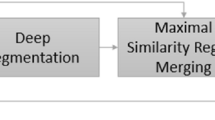Abstract
Among the most critical problems is minimising vehicle-animal accidents on highways, which cause environmental imbalances and huge public expenditures. This work covers the components of a detect and categorises the species of trapped picture with crop using bbox detect by automatically selecting the shared closest neighbour pixel to detect the large data set detected by MegaDetector. The model automatically selects the weighted average pixel using KNN regression to find the nearest neighbour of SNN density to group the minimal number of points. The ASNNP model crop the trapped image with high accuracy as well as, minimal loss identified in learning rate. The proposed and presented techniques are evaluated based on their ability to meet the mean average precision 8.02 MB (mAP) and detection speed with 94.2 in VGG16.
Access this chapter
Tax calculation will be finalised at checkout
Purchases are for personal use only
Similar content being viewed by others
References
Sundar SS, Bellur S, Oh J, Jia H, Kim HS (2016) Theoretical importance of contingency in human-computer interaction: effects of message interactivity on user engagement. Commun Res 43(5):595–625
Zuboff S (2019) The age of surveillance capitalism: the fight for a human future at the new frontier of power: Barack Obama’s books of 2019. Profile books
Schneider S, Taylor GW, Kremer S (2018) Deep learning object detection methods for ecological camera trap data. In: 2018 15th Conference on computer and robot vision (CRV). IEEE
Breckenridge RP, Dakins M, Bunting S, Harbour JL, White S (2011) Comparison of unmanned aerial vehicle platforms for assessing vegetation cover in sagebrush steppe ecosystems. Rangeland Ecol Manage 64(5):521–532
Hussain L, Saeed S, Awan IA, Idris A, Nadeem MS, Chaudhry QU (2019) Detecting brain tumor using machines learning techniques based on different features extracting strategies. Curr Med Imaging 15(6):595–606
Pal SK, Pramanik A, Maiti J, Mitra P (2021) Deep learning in multi-object detection and tracking: state of the art. Appl Intell 51(9):6400–6429
Zhu L, Tran D, Sevilla-Lara L, Yang Y, Feiszli M, Wang H (2020) Faster recurrent networks for efficient video classification. In: Proceedings of the AAAI conference on artificial intelligence, vol 34, no 07
Russakovsky O, Deng J, Su H, Krause J, Satheesh S, Ma S, Huang Z, Karpathy A, Khosla A, Bernstein M, Berg AC (2015) Imagenet large scale visual recognition challenge. Int J Comput Vis 115(3):211–252
Sen PC, Hajra M, Ghosh M (2020) Supervised classification algorithms in machine learning: a survey and review. Emerging technology in modelling and graphics. Springer, Singapore, pp 99–111
Srivastava S, Divekar AV, Anilkumar C, Naik I, Kulkarni V, Pattabiraman V (2021) Comparative analysis of deep learning image detection algorithms. J Big Data 8(1):1–27
Besteiro R, Arango T, Rodríguez MR, Fernández MD, Velo R (2018) Estimation of patterns in weaned piglets’ activity using spectral analysis. Biosyst Eng 173:85–92
Jaskó G, Giosan I, Nedevschi S (2017) Animal detection from traffic scenarios based on monocular color vision. In: 2017 13th IEEE international conference on intelligent computer communication and processing (ICCP). IEEE
Norouzzadeh MS, Nguyen A, Kosmala M, Swanson A, Palmer MS, Packer C, Clune J (2018) Automatically identifying, counting, and describing wild animals in camera-trap images with deep learning. Proc National Acad Sci 115(25):E5716–E5725
Parham J, Stewart C, Crall J, Rubenstein D, Holmberg J, Berger-Wolf T (2018) An animal detection pipeline for identification. In: 2018 IEEE winter conference on applications of computer vision (WACV). IEEE
Gupta P, Verma GK (2017) Wild animal detection using discriminative feature-oriented dictionary learning. In: 2017 International conference on computing, communication and automation (ICCCA). IEEE
Chen JIZ, Zong JI (2021) Automatic vehicle license plate detection using K-means clustering algorithm and CNN. J Electr Eng Autom 3(1): 15–23
Manoharan JS (2021) Capsule network algorithm for performance optimization of text classification. J Soft Comput Paradigm (JSCP) 3(01):1–9
Pandian AP (2021) Performance evaluation and comparison using deep learning techniques in sentiment analysis. J Soft Comput Paradigm 3(2):123–134
Huber R, Ghilardi MF, Massimini M, Ferrarelli F, Riedner BA, Peterson MJ, Tononi G (2006) Arm immobilization causes cortical plastic changes and locally decreases sleep slow wave activity. Nat Neurosci 9(9):1169–1176
Author information
Authors and Affiliations
Corresponding author
Editor information
Editors and Affiliations
Rights and permissions
Copyright information
© 2023 The Author(s), under exclusive license to Springer Nature Singapore Pte Ltd.
About this paper
Cite this paper
Anantha Babu, S., Manikandan, V., Jaiganesh, M., John Basha, M., Divya, P. (2023). Detecting Wildlife Trapped Images Using Automatically Shared Nearest Neighbouring Pixels (ASNNP). In: Smys, S., Kamel, K.A., Palanisamy, R. (eds) Inventive Computation and Information Technologies. Lecture Notes in Networks and Systems, vol 563. Springer, Singapore. https://doi.org/10.1007/978-981-19-7402-1_1
Download citation
DOI: https://doi.org/10.1007/978-981-19-7402-1_1
Published:
Publisher Name: Springer, Singapore
Print ISBN: 978-981-19-7401-4
Online ISBN: 978-981-19-7402-1
eBook Packages: EngineeringEngineering (R0)




